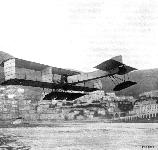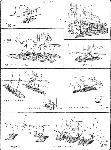В.Шавров История конструкций самолетов в СССР до 1938 г.
"Вуазен-Канар" был одним из первых в мире гидросамолетов и представлял собой по существу вариант сухопутного "Вуазена" типа 1909 г. Двигатель - "Гном" в 50 л с. Коробка крыльев трехстоечная с четырьмя вертикальными переборками. Фюзеляж с двух- и трехместной кабиной. Четыре поплавка имели вид плоских широких фанерных коробок, плоских снизу, выпуклых сверху, с заостренными передней и задней кромками. Крепление - с пружинной амортизацией на задних стойках Три поплавка были установлены под крыльями, четвертый - под носом.
Самолет был приобретен в двух экземплярах В 1912-1913 гг. в Севастополе на нем было совершено много полетов.
Самолет||
Год выпуска||1911
Двигатель, марка||
Мощность, л.с.||50
Длина самолета, м||8
Размах крыла, м||12
Площадь крыла, м2||40
Масса пустого, кг||550
Масса топлива+ масла, кг||50
Масса полной нагрузки, кг||270
Полетная масса, кг||820
Удельная нагрузка на крыло, кг/м2||20,5
Удельная нагрузка на мощность, кг/лс||16,4
Весовая отдача,%||33
Скорость максимальная у земли, км/ч||70
Скорость посадочная, км/ч||60
H.King Aeromarine Origins (Putnam)
Once again the name of Voisin presents itself, and in yet another tribute to it I record that the world's first successful amphibious heavier-than-air craft was a Voisin canard biplane. In addition to its wheels this was fitted with three Fabre floats, and during August 1911, piloted by Maurice Colliex, it took off from Issy on its wheels and alighted on the Seine, afterwards making the return journey. The take-off run from water was about 200 yards.
Nor was this a 'one-off' freak, for Gabriel recalls that he delivered to the Russian Government 'eight to ten amphibious "canard" types'; and a Voisin canard 'hydro-aeroplane' was the first marine aircraft delivered to the French Navy (mid-1912). It was housed in a special hangar aboard the battleship Foudre.
L.Opdyke French Aeroplanes Before the Great War (Schiffer)
Deleted by request of (c)Schiffer Publishing
Canard prototype, 1911: This new design used one of the old rib-shaped triplane fuselages, probably from the third of the earlier triplanes, or perhaps from the abandoned Flying Fish. The fuselage frame was hung between the wings of the biplane cells - taken from a standard Voisin - with wires, to avoid the stresses of struts on a fuselage not designed for it. Ailerons were fitted to both upper and lower wings. In the course of testing, winglets were added behind the forward elevators, the fuselage was covered, and the front fin was enlarged. It carried up to 3 people, and was later mounted on floats.
(Span: 10 m; speed: 76 kmh; 50 hp Gnome)
The second canard design, larger than the first, was meant as an amphibian, with 4 floats and attached wheels. Voisin demonstrated this 17-meter span machine by taking off the wings and driving it through the streets of Paris.
Production canards, 1911: Larger than the prototype, 3 of them were sold to Russia. They each spanned some 11m. One 3-float amphibian, different from the others, was built in 1912 specially for the French Navy.
Canard 1912: Further 3-seater canard developments of the 1911 design were built, experimenting with various combinations of rudder and front elevator controls.
(Span: c 17 m)
Type Monaco (canard): The final Voisin canard was similar to the 3 previous, but smaller, with 4 floats, built specially for the meet at Monaco. Voisin built 2 for the Monaco meet.
Jane's All The World Aircraft 1913
VOISIN. Voisin Aeroplanes, Boulevard Gambetta, Issy le Molineux, (Seine). School: Mourmelon. Capital 1,000,000 francs. The oldest aeroplane firm in the world, founded by the Brothers Voisin in 1905. (See past editions).
Latest models are:
Military Military
Model and date. biplane. Hydro-biplane. biplane.
Model 1912. Model 1912. Model 1913.
Length......feet(m.) 37? (11.50) 36 (11) 32? (10)
Span........feet(m.) 55? (17) 43? (13.50) 45-1/3 (13.80)
Area....sq.feet(m?.) 387 (36) 376 (35) 398 (37)
Weight,
total....lbs.(kgs) 1367 (620) 1212 (550) 1102 (500)
useful...lbs.(kgs) 772 (350) 661 (300) 794 (360)
Motor..........h.p. 70 Renault 100 Gnome 80 Gnome
Speed,
max....m.p.h.(km.) 62 (100) 62 (100) 65 (105)
min....m.p.h.(km.) ... ... ...
Number built
during 1912 47 8 ...
Журнал Flight
Flight, January 14, 1911
A New Voisin Machine.
AT the present time when most builders are abandoning the front elevator in favour of one placed at the rear, it is very interesting to notice that MM. Voisin Freres have turned out a biplane which is distinguished by the fact that it has an elevator in front, while there is an entire absence of any tail at the rear. From the accompanying photograph it will be seen that the monoplane elevator is placed a very long way in front of the main plane and that the rudder is also mounted above the elevator in front. The 50-h.p. Rossel Peugeot rotary motor and metal propeller are arranged at the rear edge of the main plane in very much the usual manner, and it will be noticed that lateral stability is maintained by means of balancing flaps at the ends of the main plane. The aviator sits some distance in advance of the main planes with the controlling levers of the usual type arranged in front of him. The position of the pilot is such that should any part of the engine break, it is extremely unlikely that it would injure him, while he is also able to get a good view of his surroundings. Needless to say the trials of this novel machine, seeing that it is the work of the Voisins, will be watched with great attention by all having any interest in aviation.
The main planes, which are placed 1.6 metres apart, have a span of 12 metres, while the chord is 2.2 metres, so that the bearing surface amounts to 26-4 square metres. The monoplane elevator measures 4 metres by 3.2 metres, and so the area is 12.8 square metres. The fuselage, which carries the elevator in front and the motor and propeller at its after end, is a long rectangular framework mounted on a modification of the usual type of Voisin landing chassis while at its forward end are arranged a supplementary pair of wheels to assist in landing. In this connection it will be remembered that Santos Dumont's first successful flight was made on a biplane with a box form elevator mounted a considerable distance in front of the main planes, which gave the machine the appearance of flying tail first. This was illustrated in the Automotor Journal of November 24th, 1906.
Flight, February 25, 1911
Things They Do Better in France.
IN order to assist aviators who intend to take part in a flight from Nice to Sartene, in Corsica, the Naval Commander at Toulon has received instructions to permit the cruiser "Polypheme" and two torpedo boats to render what assistance they can in the way of escort to the aviators. It is announced that Bregi, on a Voisin of the "Canard" type, intends to have a try shortly to win the prize. Bregi is now practising on this machine at Issy, the other day making on it a flight of over half-an-hour.
Flight, June 10, 1911.
FOREIGN AVIATION NEWS.
The Voisin Hydro-Aeroplane.
ON the 25th ult., the special Voisin biplane of the Canard type, which has been built for Prince Bibesco and equipped with floats for rising from and descending on to the surface of the water, was tried on the Seine in the neighbourhood of Billancourt. Piloted by Colliex, the machine first glided for a distance of about 100 meties, and then rising from the water flew for about 500 metres, being stopped by Colliex as it approached the Auteuil Viaduct. The trials then had to be suspended, as the ferry boats rendered it impossible to continue.
Flight, December 30, 1911.
PARIS AERO SHOW.
Voisin.
THE Canard on view on this stand is essentially the same in every detail as those which represented the Voisin firm in the Military Trials at Rheims, with the exception that, being designed to rise from and alight on water the usual landing gear is replaced by a system of floats.
Principal dimensions, &c. :-
Length 26 ft. Weight 1,210 lbs.
Span 40 ,, Speed 56 m.p.h.
Area 473 sq.ft. Motor 70-h.p. Gnome.
Price L1,200.
 |
Журнал - Flight за 1911 г.
|
| THE LATEST VOISIN MACHINE. - View from the side of the latest biplane constructed by MM. Voisin Freeres.
|
 |
L.Opdyke - French Aeroplanes Before the Great War /Schiffer/
|
| THE NEW VOISIN. - The elevating and steering planes in front. This machine was dealt with in FLIGHT on January 14th.
|
 |
L.Opdyke - French Aeroplanes Before the Great War /Schiffer/
|
| The 1911 canard prototype in full flight. Not quite in its first form, this version has the new forward eyebrow winglets.
|
 |
L.Opdyke - French Aeroplanes Before the Great War /Schiffer/
|
| Probably the Voisin canard prototype in a later form, in full flight.
|
 |
Журнал - Flight за 1911 г.
|
| BREGI IN FULL FLIGHT ON THE NEW VOISIN, WITH ITS FUSELAGE IN FRONT. - Note in left photograph the head of the pilot just showing above the enclosed fuselage.
|
 |
H.King - Aeromarine Origins /Putnam/
|
| The Voisin 'canard' in which Maurice Colliex, during August 1911, took off from Issy aerodrome and alighted on the Seine, afterwards making the return trip. This was the first successful amphibian.
|
 |
L.Opdyke - French Aeroplanes Before the Great War /Schiffer/
|
| Probably the second canard, it is being tested by Colliex on the Seine, on 6 August 1911.
|
 |
H.King - Aeromarine Origins /Putnam/
|
|
|
 |
L.Opdyke - French Aeroplanes Before the Great War /Schiffer/
|
| One of the 1911 production canards of 1911, specially built for testing by the French navy. Here it is on board La Foudre.
|
 |
L.Opdyke - French Aeroplanes Before the Great War /Schiffer/
|
| Voisin canard of 1912. Note the variations in the front ends, and the attachment of the forward elevators. Sometimes photographs can be matched through the patterns of oil and grease spots.
|
 |
Журнал - Flight за 1911 г.
|
| The Voisin "Canard" on the Seine, fitted with her floats.
|
 |
L.Opdyke - French Aeroplanes Before the Great War /Schiffer/
|
| One of the 2 Types Monaco built by Voisin for this meet in 1912. Following his success, Henri Farman specialised in float design. He designed and built the floats for this Voisin canard seaplane, seen here at the hydro-aeroplane meeting at Monaco in 1912.
|
 |
Журнал - Flight за 1912 г.
|
THE HYDRO-AEROPLANES AT MONACO. - The Voisin Canard well up in a flight over the course.
Fabre floats were adopted for several types of aircraft. This Voisin 'canard' had no fewer than four.
|
 |
В.Шавров - История конструкций самолетов в СССР до 1938 г.
|
| "Вуазен-Канар"
|
 |
L.Opdyke - French Aeroplanes Before the Great War /Schiffer/
|
| One of the 3-seat canards of 1912. Note the variation among these later canard designs.
|
 |
L.Opdyke - French Aeroplanes Before the Great War /Schiffer/
|
| Another view of the aircraft in the preceding photograph.
|
 |
L.Opdyke - French Aeroplanes Before the Great War /Schiffer/
|
|
|
 |
Журнал - Flight за 1911 г.
|
| THE NEW VOISIN. - The pilot's seat - Colliex is in charge - showing the arrangement of steering gear, &c.
|
 |
Журнал - Flight за 1911 г.
|
| The Voisin "Canard" equipped with floats.
|
 |
Журнал - Flight за 1913 г.
|
| HYDRO-AEROPLANES. - Fig. 5. - Types of Aeroplanes.
|
 |
Журнал - Flight за 1912 г.
|
| Hydro-aeroplanes, illustrating the paper by Mr. Holt Thomas.
|






















